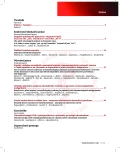Chronic benign CD8+ lymphoproliferation in a patient after rituximab treatment
Authors:
M. Osovská 1; A. Janíková 1; L. Křen 2; A. Marečková 3
Authors‘ workplace:
Interní hematoonkologická a onkologická klinika, FN Brno a LF MU, Brno
1; Ústav patologie, FN Brno a LF MU, Brno
2; Centrum molekulární biologie a genové terapie, FN Brno
3
Published in:
Transfuze Hematol. dnes,24, 2018, No. 1, p. 53-57.
Category:
Case Reports
Overview
Chronic benign CD8+ proliferation is a rare affection that can mimic a variety of other diseases. It clinically manifests as cytopenia or infiltration of lymph nodes, liver, kidneys, the bowel and other organs. CD8+ expansion can be clonal or non-clonal and generally occurs in patients with innate or acquired immunodeficiency (HIV+) or in patients on immunosuppressive treatment. It has also been detected in patients following rituximab (anti-CD 20 antibody) treatment. The diagnosis can be difficult a standard biopsy may not identify the problem at first sight. We describe the case of a patient with lymphoma in remission pre-treated with rituximab, who was suspected of systemic relapse of her lymphoma (lymphadenopathy, fever, liver enzymes elevation). Biopsy of an enlarged lymph node showed “reactive lymphadenitis”. Flow cytometry revealed a pathological population of CD8+ lymphocytes. The treatment, quite different from that of lymphoma relapse, consisted of corticosteroids and regular IVIG administration led to regression of all clinical and laboratory signs. As rituximab is used more and more frequently, we can expect an increased incidence of this entity.
key words:
chronic CD8+ lymphoproliferation – follicular lymphoma – maintenance rituximab therapy – adverse effects of rituximab
Sources
1. Ghrenassia E, Roulin L, Aline-Fardin A, et al. The spectrum of chronic CD8+ T-cell expansions: clinical features in 14 patients. PLoS ONE 2014;9(3):e91505.
2. Pereira BI, Akbar AN. Convergence of innate and adaptive immunity during human aging. Front Immunol 2016;7:445.
3. Strioga M, Pasukoniene V, Characiejus D. CD8+ CD28− and CD8+ CD57+ T cells and their role in health and disease. Immunology 2011;134(1):17–32.
4. Brugnoni D, Prati E, Cattaneo R, et al. The primary response to HIV infection is characterized by an exapansion of activated CD8+CD28 – cells. AIDS 1996;10:104–106.
5. Mudd JC, Lederman MM. CD8 T cell persistence in treated HIV infec-tion. Curr Opin HIV AIDS 2014;9(5):500–505.
6. Smith PR, Cavenagh JD, Milne T, et al. Benign monoclonal expansion of CD8+ lymphocytes in HIV infection. J Clin Pathol 2000;53(3):177–181.
7. Ghrenassia E, Martis N, Boyer J, et al. The diffuse infiltrative lymphocytosis syndrome (DILS). A comprehensive review. J Autoimmun 2015;59:19–25.
8. Viallard JF, Ruiz C, Guillet M, Pellegrin JL, Moreau JF. Perturbations of the CD8(+) T-cell repertoire in CVID patients with complications. Rsults Immunol 2013;3:122–128.
9. Szablewski V, René C, Costes V. Indolent cytotoxic T cell lymphoproliferation associated with nodular regeneratve hyperplasia: a common liver lesion in the context of common variable immunodeficiency disorder. Virchow Arch 2015;467(6):733–740.
10. Ghielmini M, Vitolo U, Kimby E, et al. ESMO Guidelines consensus conference on malignant lymphoma 2011 part 1: diffuse large B-cell lymphoma (DLBCL), follicular lymphoma (FL) and chronic lymphocytic leukemia (CLL). Ann Oncol 2013;24:561–576.
11. Griffin MM, Morley N. Rituximab in the treatment of non-Hodgkin´s lymphoma – a critical evaluation of randomized controlled trials. Expert Opin Biol Ther 2013;13:803–811.
12. Zinzani PL, Marchetti M, Billio A, et al. SIE, SIES, GITMO revised guidelines for the management of follicular lymphoma. Am J Hematol 2013;88:185–192.
13. Salles G, Seymour JF, Offner F, et al. Rituximab maintenance for 2 years in patients with high tumour burden follicular lymphoma responding to rituximab plus chemotherapy (PRIMA): a phase 3, randomised controlled trial. Lancet 2011;377:42–51.
14. Vidal L, Gafter-Gvilli A, Sales G, et al. Rituximab maintenance for the treatment of patients with follicular lymphoma: an updated systematic review and meta-analysis of randomized trials. J Natl Cancer Inst 2011;103:1799–1806.
15. Cohen JB, Zain JM, Kahl BS. Current approaches to mantle cell lymphoma: diagnosis, prognosis, and therapies. American Society of Clinical Oncology Educational Book 2017;37:512–525.
16. Vaishalee K, Walter L, Jense E, et al. Maintenance rituximab following induction chemo-immunotherapy for mantle cell lymphoma: long-term follow-up of a pilot study from the Wisconsin Oncology Network. Leuk Lymphoma 2011;52(9):1675–1680.
17. Inoue N, Nishimura N, Takahasho A, et al. Rituximab maintenance therapy is an effective therapy in over-sixties with mantle cell lymphoma. Blood 2015;126(23):5081.
18. Casulo C, Maragulia J, Zelenetz A. Incidence of hypogamaglobulinemia in patients receiving rituximab and the use of intravenous immunoglobulin for recurrent infections. Clin Lymphoma Myeloma Leuk 2013;13(2):106–111.
19. Cattaneo C, Spedini P, Casari S, et al. Delayed-onset peripheral blood cytopenia after rituximab: frequency and risk factor assessment in a consecutive series of 77 patients. Leuk Lymphoma 2006;47(6):1013–1017.
20. Nabhan C, Ollberding NJ, Villines D, et al. A systematic review of comparative schedule-related toxicities with maintenance rituximab in follicular and mantle cell lymphomas. Leuk Lymphoma 2014;55:1288–1294.
21. Obořilová A, Mayer J. Účinnost monoklonální protilátky anti-CD20 – rituximabu v léčbě folikulárního lymfomu. Transfuze Hematol dnes 2003;9(4):170–177.
22. Irie E, Shirota Y, Suzuki C, et al. Severe hypogammaglobulinemia persisting for 6 years after treatment with rituximab combined chemotherapy due to arrest of B lymphocyte differentiation together with alteration of T lymphocyte homeostasis. Int J Hematol 2010;91(3):501–508.
23. Janíková A, Mayer J, Král Z. Aktuální pohled na udržovací terapii rituximabem (“rituximab-maintenance”) u folikulárního lymfomu. Transfuze Hematol dnes 2008;14:79–85.
Labels
Haematology Internal medicine Clinical oncologyArticle was published in
Transfusion and Haematology Today

2018 Issue 1
Most read in this issue
- Delayed donor reactions to blood donations – anonymous electronic survey
- Inherited thrombocytopenias
- Use of central venous catheters in haematological patients and associated infections: overview of the situation in the Czech and Slovak Republics and recommendations for prevention and diagnosis
- Chronic benign CD8+ lymphoproliferation in a patient after rituximab treatment
